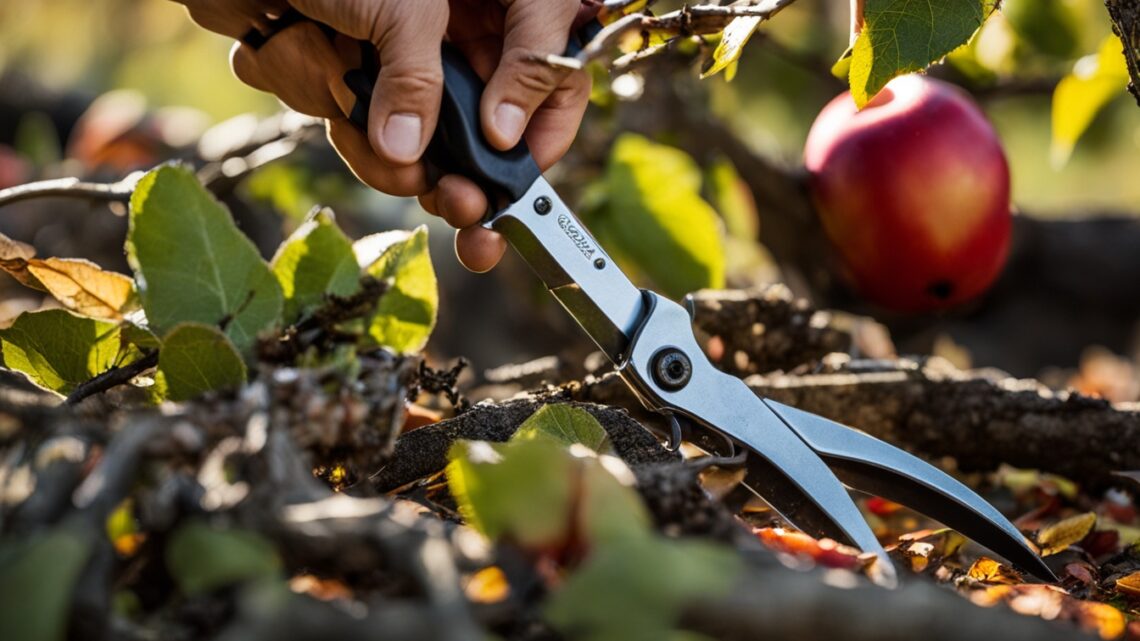
Are you having trouble with your fruit trees? The key is in pruning fruit trees. It’s a key part of taking care of your orchard. By pruning right, you can make your trees grow better and produce more.
This guide will show you how to make your fruit trees do well. You’ll learn why pruning is important and how to do it at the right time. With these tips, you can make your fruit trees better and increase your harvest.
Pruning Fruit Trees: Why It’s Crucial
Pruning fruit trees is key for their health and productivity. It helps stimulate fruit tree growth and shape the trees well. This makes sure your trees grow strong and produce more fruit.
Stimulating Growth and Shaping Trees
Prune your trees every 2-3 years for best results. Pruning in winter helps grow new, strong branches and roots. This makes the tree balanced and boosts its pruning benefits.
It also lets you shape the tree’s structure. By cutting dead or bad branches, you help the tree grow better. This means bigger, healthier leaves and more fruit.
Pruning also stops tree diseases and pests. Cutting out sick or infested parts keeps your tree healthy. Plus, pruning makes your orchard look great.
For gardeners new or old, pruning is key for a great orchard. It helps your trees grow well and look beautiful.
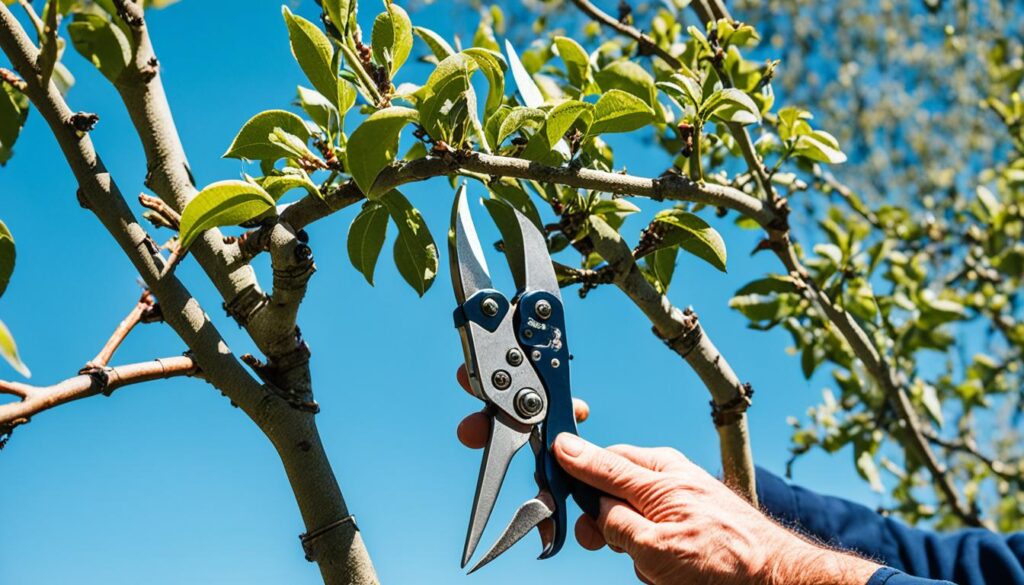
Timing is Everything: When to Prune Fruit Trees
Proper timing is key for pruning fruit trees. The best time is during the dormant season. This is late fall, winter, or early spring. Trees rest then, making it easy to see and shape them.
Pruning in the dormant season helps trees grow strong and healthy. It gets them ready for the next growing season. The best time changes with your climate and where you live.
- Plan to prune your fruit trees when they are dormant, either in late fall, winter, or early spring before bud break.
- In warmer climates, prune in late winter or early spring, before the buds begin to swell.
- In colder climates, prune in late fall or early winter, after the leaves have fallen and before the first hard freeze.
Don’t prune during the growing season. It can stress the trees and cause bad growth. Prune at the right time to keep trees healthy and full of fruit.
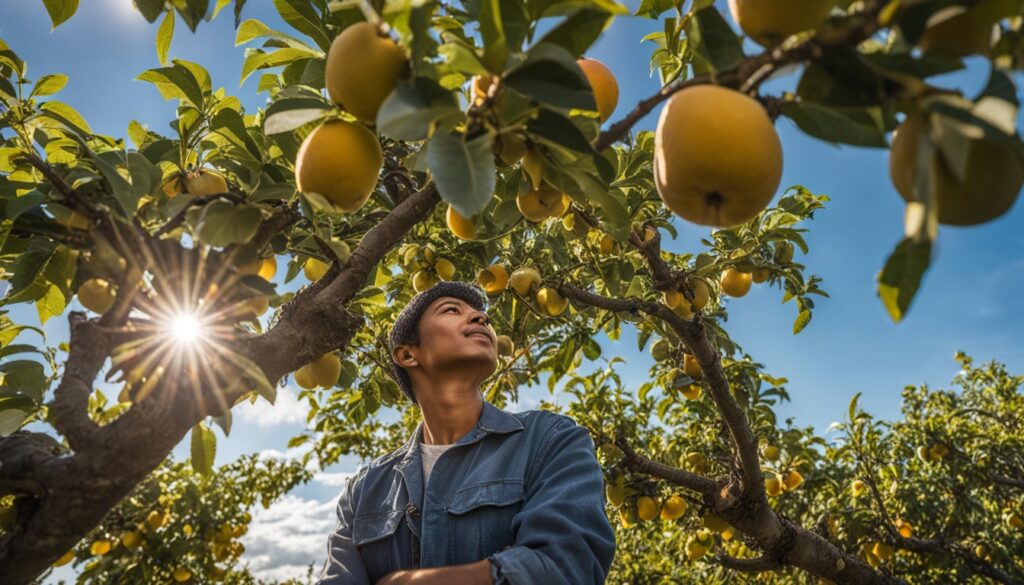
Remember, prune your fruit trees when they rest. This helps shape and grow them for the next year. By knowing when to prune fruit trees, you’ll make your orchard thrive and have a great harvest.
Pruning Techniques for Fruit Trees
Proper pruning is key for your fruit trees’ health and fruit production. There are two main pruning methods: thinning cuts and heading cuts. Each has its own purpose in shaping and managing your trees.
Thinning vs. Heading Cuts
Thinning cuts take out a whole branch at its start. This makes long, flexible branches that bend under fruit load. It helps the tree grow naturally and improves air flow.
Heading cuts cut only part of a branch. This makes branches spread out and get stiffer. Light heading can make young trees branch more.
| Thinning Cuts | Heading Cuts |
|---|---|
| Removes entire branch | Removes part of a branch |
| Leads to long, flexible limbs | Causes lateral branching and stiffer limbs |
| Promotes open, natural growth habit | Can stimulate branching in young trees |
Knowing the difference between thinning and heading cuts helps you use fruit tree pruning techniques well. This way, you can shape your trees, help them grow healthy, and increase fruit production.
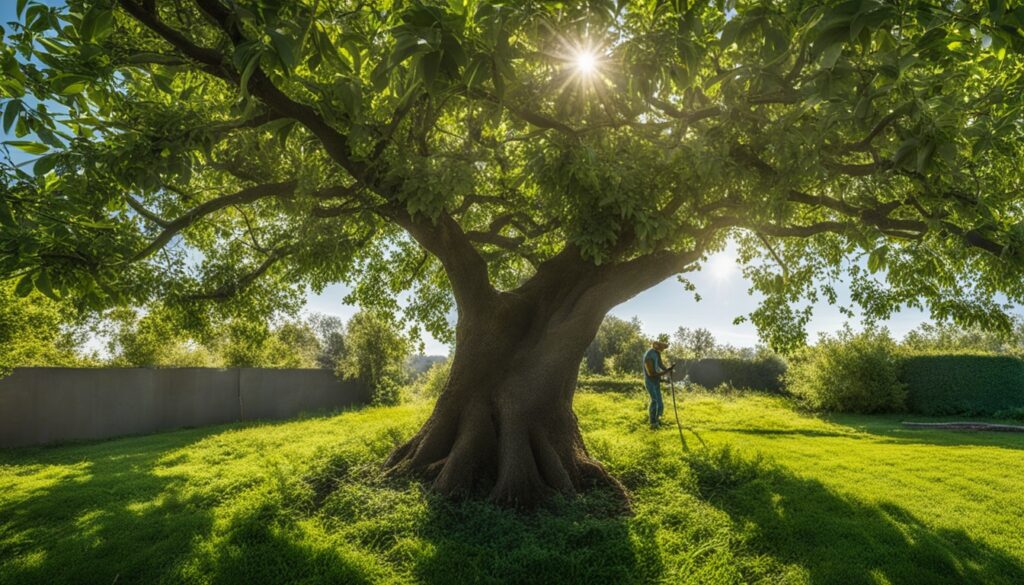
pruning fruit trees: Essential Tools and Methods
Pruning fruit trees needs the right tools and techniques for their health and productivity. It’s important to make clean, sharp cuts just outside the branch collar. This area helps seal off wounds from fungi.
Avoid leaving stubs or making flush cuts. These can cause problems later.
Some think using wound dressings helps prevent wood rots. But, there’s no proof for this. So, focus on making the right cuts and letting the tree heal naturally.
- Pruning tools for fruit trees should include a hand pruner, long-handled lopping shears, and a pruning saw. These three tools cover most pruning needs.
- Pruning methods like thinning cuts remove a whole shoot or branch. They’re better than heading cuts, which only take part of a shoot or branch. Thinning cuts help with fruit growth by letting in more light.
- Pruning best practices mean pruning during the dormant season, from November 15 to April 15. This helps reduce stress on the tree and helps it recover better.
Using the right pruning tools for fruit trees, pruning methods, and pruning best practices keeps your fruit trees healthy and productive.
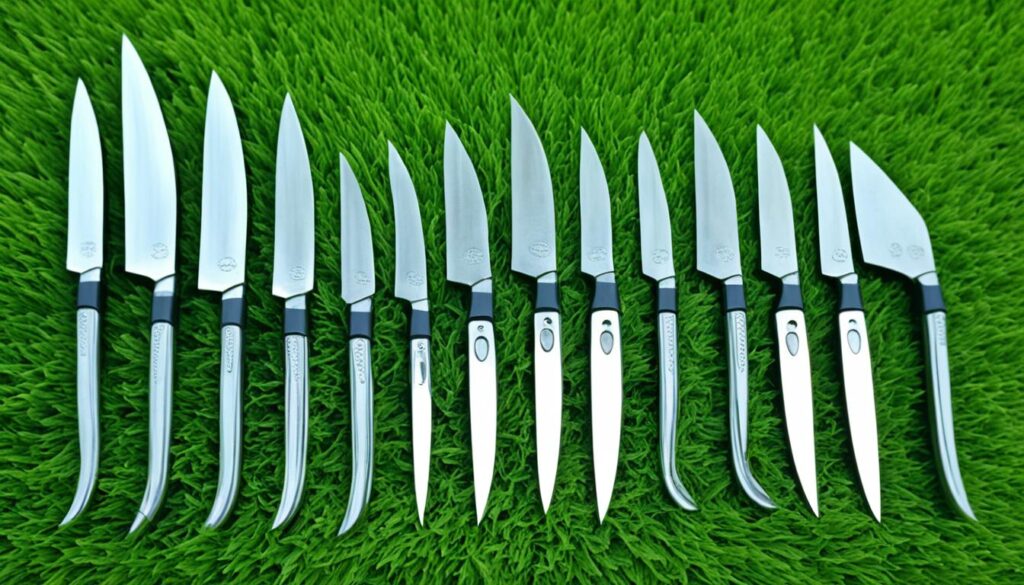
Training Young Fruit Trees
Training and pruning young fruit trees is key to their success. There are two main ways to do this: the central leader system and the open center system. Knowing the differences between them helps you pick the best method for your trees and garden goals.
Central Leader System
The central leader system makes a tree look like a pyramid with one main branch at the top. It’s great for apple, cherry, pear, pecan, and plum trees. It’s important to keep the main branch strong and space the side branches right to support heavy fruit.
Open Center System
The open center system doesn’t have a main leader. Instead, it has 3 to 5 main branches that spread out from the trunk. This is perfect for stone fruits like peaches and nectarines. It lets more sunlight and air into the tree, which helps it stay healthy and produce more fruit.
It’s best to train young fruit trees during their first five years. Choosing and taking care of the main branches is crucial. This makes sure your tree grows strong, can carry a lot of fruit, and looks good in your garden.
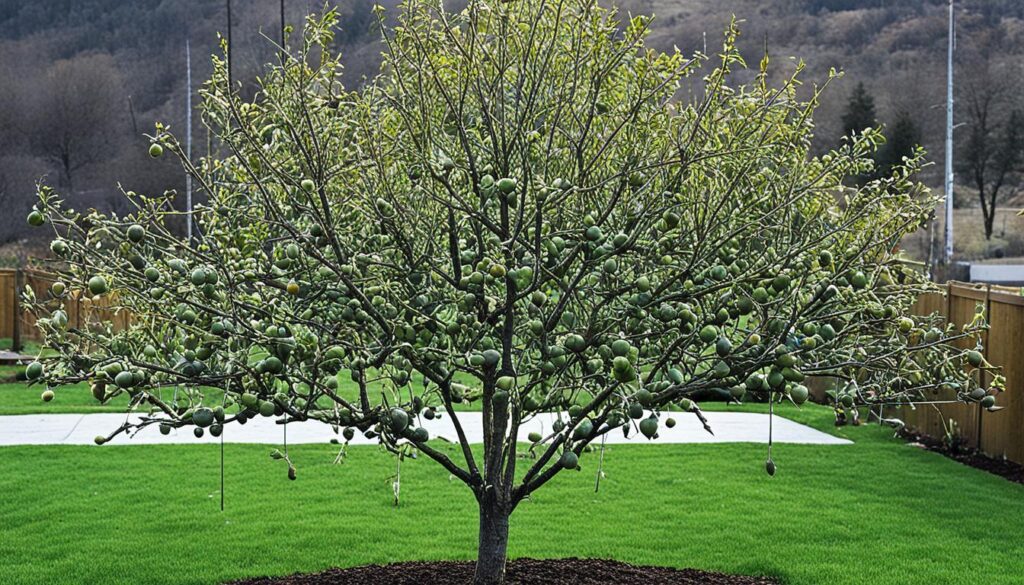
Learning how to train young fruit trees sets your orchard up for success. You’ll get lots of fruit for many years.
Pruning Mature Fruit Trees
As fruit trees get older, pruning changes to keep them productive and fruit quality high. This means cutting some shoots that grow at the ends of branches. This makes the fruit bigger and better.
When a tree gets too tall, cutting the top limbs back to a side branch is key. Make sure to cut cleanly, without leaving stubs. This stops water sprouts and keeps the tree looking nice.
Old fruit trees can get huge and hard to handle. Apple and pear trees are easy to fix, while cherries can also be brought back. But, peaches and nectarines are best replaced rather than fixed.
To make an old tree smaller, do it slowly over three years. Cut off no more than one-third of the tree each year. This helps the tree stay healthy while it’s being fixed.
| Tree Type | Ideal Height |
|---|---|
| True Dwarf | 6 to 10 feet |
| Semi-Dwarf | 10 to 16 feet |
| Standard | 16 to 20 feet |
For better fruit and light, remove 65 to 70 percent of the tree’s bearing surface when pruning. This lets the branches get enough sunlight and air. These are key for good fruit.
Renovating old fruit trees takes about three to four years. After the last pruning year, give the tree a light dose of fertilizer. Use 0.5 pounds of 5-10-10 for each inch of trunk size. This helps the tree grow strong and healthy.
Fruit Tree Pruning: Common Mistakes to Avoid
Proper pruning is key for your fruit trees’ health and productivity. Even experienced gardeners can make mistakes that hurt their trees. Let’s look at common pruning errors to avoid with your fruit trees.
One big mistake is pruning at the wrong time of year. In Florida, prune your trees in the winter when they’re dormant. Pruning in the growing season can stress the tree and lower fruit quality. A professional arborist can make sure your trees are pruned right.
Another error is over-pruning. It’s easy to cut too much, which can harm the tree’s health and reduce fruit. Experts know how much to prune to keep the tree the right size and shape. This also helps with air flow and sun exposure.
- Using the wrong tools or dull blades can hurt the tree, leading to decay and disease.
- Incorrect cuts, like flush cuts or stubs, can also harm the tree’s health.
- Topping a tree, or cutting the main leader, makes it unstable and more likely to get pests and diseases.
To keep your fruit trees healthy and productive, avoid these common pruning mistakes. Follow best practices and get help from a pro if you need it. This way, you can enjoy lots of fruit for many years.
| Pruning Mistake | Potential Consequences |
|---|---|
| Pruning at the wrong time of year | Stress on the tree, reduced fruit quality |
| Over-pruning | Health issues, decreased fruit production |
| Using dull or incorrect tools | Damage to the tree, decay and disease |
| Improper cuts (flush cuts, stubs) | Compromised tree health |
| Topping the tree | Tree instability, pests and diseases |
Avoid these common fruit tree pruning mistakes to keep your trees healthy and productive. This way, you’ll get lots of fruit for years.
Pruning for Specific Fruit Types
Pruning fruit trees depends on the tree type. Each fruit tree has its own way of growing and producing fruit. Knowing how each tree grows helps with pruning to keep trees healthy and productive.
Peaches, Apples, and More
Peach trees grow fruit on last year’s wood. So, they need a lot of pruning to make new fruiting wood. Apple and pear trees grow fruit on spurs. Pruning them is about keeping the tree balanced and open.
Pruning different fruit trees needs a special approach for their fruiting habits. For pruning peach trees, cut a lot of last year’s growth to get new fruitful shoots. Pruning apple trees is about making a wide, open canopy for light and air. This helps with fruit quality and keeps diseases away.
Other fruit trees like pears, plums, and cherries also have their own pruning needs. Knowing what each tree needs is important for good pruning results.
| Fruit Tree Type | Pruning Approach |
|---|---|
| Peach | Prune heavily to stimulate new fruiting wood |
| Apple | Focus on maintaining a balanced, open structure |
| Pear | Similar to apple trees, emphasize an open canopy |
| Plum | Prune to control size and shape, remove water sprouts |
| Cherry | Prune to maintain an open, vase-like form |
Knowing how to prune different fruit trees helps gardeners and orchardists. It keeps trees healthy, productive, and their fruit quality high.
Espalier Training: A Space-Saving Solution
Imagine growing your own fruit trees in tiny spaces. Espalier training is a great way to do this. It trains trees to grow flat along a trellis or wire. This lets you have fresh fruit without using much garden space.
Apple and pear trees work well for espalier training. They bend easily and are perfect for this method. This old way of growing trees started in Europe and ancient Egypt. Now, you can grow these trees in just 6 to 8 feet of space.
Looking after an espaliered tree takes some work. You need to prune and train it regularly. But, it’s worth it because these trees save space and are easier to care for. You can start getting fruit the second year after planting.
To make an espaliered tree, set up a strong trellis or wire system. Use posts 8 feet apart and wire that’s 12-gauge or thicker. Then, train the branches along the wires. Make sure to leave «spurs» every 6 inches for fruit.
Adding more tiers to your tree makes it look great and saves even more space. This method is perfect for small gardens or city balconies. With some patience and effort, you can turn a small area into a fruitful orchard.
Pruning for Improved Fruit Quality
Pruning your fruit trees is key to better fruit quality. By thinning out too much growth and cutting off competing shoots, you help the tree focus on making fewer, but bigger and tastier fruits. Using the right pruning methods and carefully removing some fruit can lead to more and better harvests.
Pruning helps make fruits bigger. By taking off some fruits, the rest get more of the tree’s resources. This makes them grow bigger and taste better. This is especially true for fruits like peaches, nectarines, and apples that can carry too many fruits.
Pruning also makes fruits taste better. By trimming the tree, you let more sunlight in. This sunlight helps the fruits grow sweeter and tastier. It’s like giving them a special boost.
| Fruit Type | Pruning Recommendations |
|---|---|
| Apples | Remove upright shoots, dead wood, and balance branch growth for optimal light exposure and fruit production. |
| Peaches and Nectarines | Require heavy annual pruning as they bear fruit only on one-year-old shoots. |
| Plums | Spurs may bear fruit for 5 to 8 years, requiring less frequent pruning than other fruit trees. |
| Citrus and Avocado | Need minimal pruning compared to deciduous fruit trees, but maintaining an open canopy is essential. |
Using these pruning for fruit quality tips can make your fruit trees better. You’ll get more and tastier fruits. This will make your harvests a joy and your cooking more delicious.
Developing a Pruning Routine
It’s key to have a regular pruning plan for your fruit trees. Prune them every year when they’re dormant. This helps them stay healthy and productive. By doing annual pruning, you can prevent big problems later. Your trees will keep growing well and giving lots of good fruit.
Keeping fruit trees healthy means having a good pruning routine. Prune in late winter when they’re dormant. This helps them grow better. The best time can change based on where you live, as some places get colder.
Pruning your tree often helps shape it and boost fruit production. With a good developing a fruit tree pruning routine, you’ll get more fruit and have a great orchard. This way, you’ll enjoy your trees for many years.



